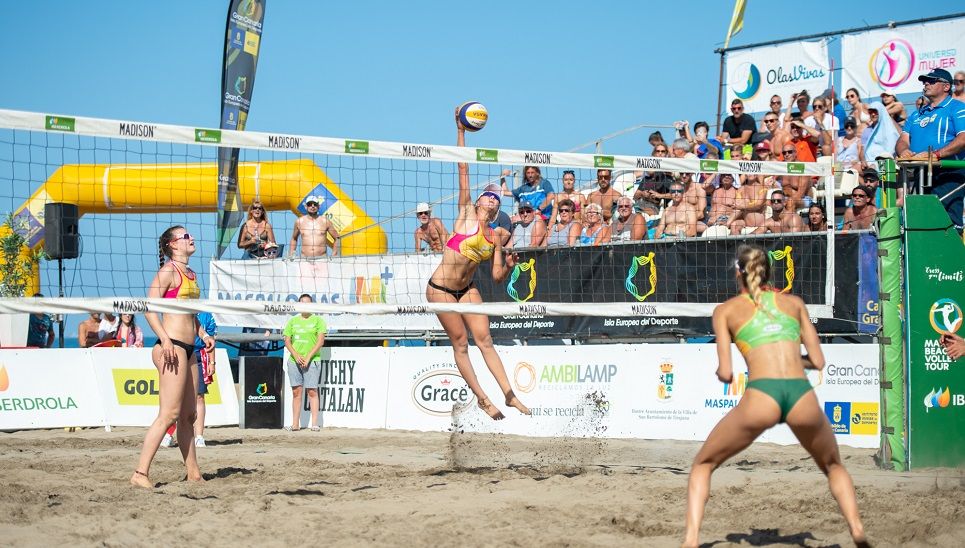Beach Volleyball: Complete Guide
Beach volleyball combines traditional volleyball technique with the unique demands of playing on sand. Discover specialized techniques, defensive tactics and physical preparation required for this exciting outdoor sport.
📋 Table of Contents

Key Differences with Indoor Volleyball
Specific Characteristics of Beach Volleyball
Beach volleyball has unique characteristics that differentiate it from indoor volleyball, requiring specific adaptations in technique, tactics and physical preparation.
Fundamental Differences
- Players: 2 players per team vs 6 in indoor
- Surface: Sand vs hard court
- Environmental factors: Wind, sun, temperature
- Specialization: Both players must be versatile
- Scoring: Best of 3 sets to 21 points
- Changes: No substitutions allowed
Impact on the Game
- Higher physical demand due to sand movement
- Greater technical versatility required
- Essential communication between partners
- Adaptation to outdoor conditions
- Energy efficiency becomes crucial
Specialized Techniques for Sand
The Serve in Beach Volleyball
The serve in beach volleyball requires precision and adaptation to outdoor conditions, especially wind and sand.
Types of Serves
- Float serve: Ball without rotation for unpredictable trajectory
- Spin serve: Ball with rotation for controlled direction
- Power serve: Maximum speed to overcome defense
- Short serve: Tactical serve to surprise the opponent
Sand Adaptations
- Stable position considering sand movement
- Wind consideration in ball trajectory
- Power control due to sand resistance
- Trajectory variation for tactical advantage
Reception on Sand
Reception in beach volleyball requires refined technique and adaptation to sand and environmental conditions.
Reception Techniques
- High reception: For difficult balls, allows better control
- Low reception: Standard technique with forearms
- One-hand reception: For very distant balls
- Fall reception: For very low balls
Setting in Beach Volleyball
Setting in beach volleyball is more versatile than on court, as both players must be able to set effectively.
Setting Characteristics
- Greater variety of setting options
- One-hand setting for difficult balls
- Setting with forearms as alternative
- Adaptation to wind conditions
- Constant communication between partners
The Attack on Sand
The attack in beach volleyball combines power and precision, adapting to sand conditions and rival defense.
Attack Techniques
- Power spike: Maximum speed to overcome defense
- Spin spike: Ball rotation to make defense difficult
- Short spike: Tactical technique to surprise
- Fall spike: For low or difficult balls
- One-hand spike: For distant balls
Sand Adaptations
- Greater power control due to sand
- Wind consideration in trajectory
- Focus on precision rather than power
- Variation of attack angles
Tactics and Defensive Formations
Basic Defensive Formations
Defensive formations in beach volleyball adapt to each pair's characteristics and game conditions.
1-1 Formation (Line)
Both players position in line, one near the net and the other in the back. It's the most common and versatile formation.
- Ideal for balanced pairs
- Good court coverage
- Facilitates attack-defense transition
- Requires good communication
2-0 Formation (Double Block)
Both players position near the net to block. It's aggressive but leaves gaps in defense.
- Maximum pressure in blocking
- Ideal for tall pairs
- Requires excellent field defense
- Effective against weak attackers
0-2 Formation (Double Defense)
Both players position in the back to prioritize defense. It's conservative but effective.
- Maximum defensive coverage
- Ideal for short pairs
- Requires excellent setting
- Effective against powerful attackers
Weak Side Strategies
Weak side strategy is fundamental in beach volleyball, taking advantage of rival weaknesses to gain advantage.
Weak Side Identification
- Analysis of each player's skills
- Observation of game patterns
- Identification of technical limitations
- Analysis of communication between pairs
Weak Side Exploitation
- Serve directed at the weakest player
- Attack towards the area of least defense
- Constant pressure on the weak point
- Tactic variation to maintain pressure
Game Reading
The ability to read the game is essential in beach volleyball, allowing anticipation of rival actions and strategy adaptation.
Reading Elements
- Position of rival players
- Rival setting patterns
- Preferred attack zones
- Communication between rival pairs
- Environmental conditions
Reading Application
- Anticipation of attack direction
- Smart defensive positioning
- Offensive strategy adaptation
- Opportunity exploitation
Physical Conditioning for Sand
Physical Demands of Beach Volleyball
Beach volleyball presents unique physical demands that require specific and complete conditioning.
Main Physical Components
- Cardiovascular endurance: Long matches in demanding conditions
- Explosive strength: For jumps and quick movements
- Muscular endurance: To maintain intensity
- Flexibility: For wide movements and injury prevention
- Coordination: For precise movements on sand
Specific Training
Training for beach volleyball should include specific exercises that simulate game conditions.
Endurance Exercises
- Sand running
- Interval exercises
- Match simulations
- Training in heat conditions
Strength Exercises
- Squats and variations
- Plyometrics
- Core exercises
- Shoulder training
Mobility Exercises
- Dynamic stretching
- Athlete yoga
- Functional movements
- Injury prevention
Adaptation to Environmental Conditions
Beach volleyball is played in variable environmental conditions that require specific adaptation.
Environmental Factors
- Wind: Affects ball trajectory
- Temperature: Impacts physical endurance
- Humidity: Affects perspiration
- Solar radiation: Requires adequate protection
Adaptation Strategies
- Training in different conditions
- Adequate hydration
- Sun protection
- Gradual acclimation
Competition Strategies
Mental Preparation
Mental preparation is fundamental in beach volleyball, where concentration and confidence are determining factors.
Key Mental Aspects
- Sustained concentration
- Stress management
- Confidence in partner
- Resilience to errors
- Constant motivation
Communication between Pairs
Effective communication between pairs is essential for success in beach volleyball.
Communication Elements
- Clear verbal signals
- Non-verbal communication
- Mutual support
- Constructive feedback
- Movement coordination
📊 Your Web Activity
Total Points
Level: Beginner
Pages Visited
Goal: 50 pages
Time on Web
Goal: 120 minutes
Quizzes Completed
Goal: 10 quizzes
